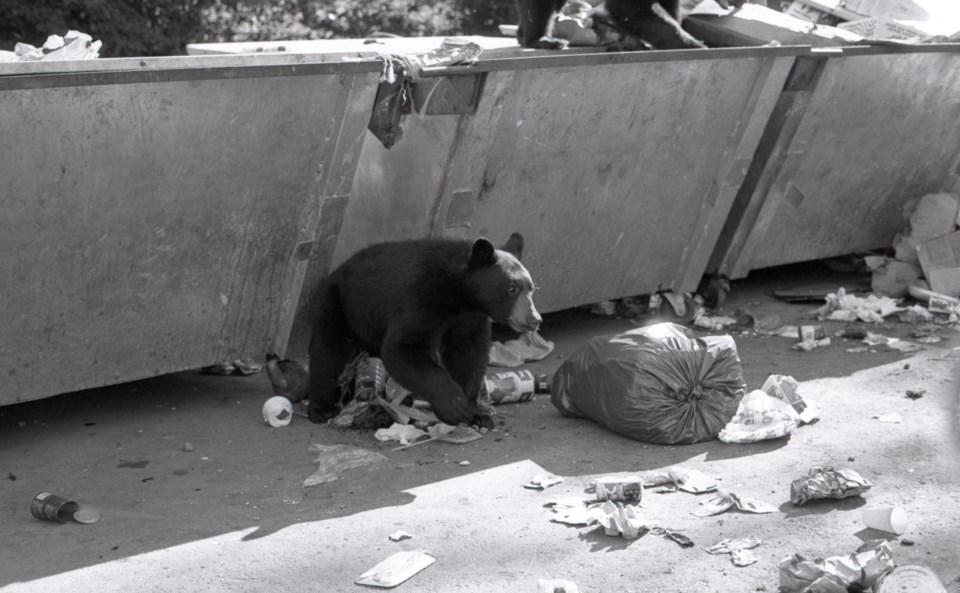When it comes to green practices in Whistler, we have come a long way from bear-attracting open dumps. Long before we had the waste collection facilities we have today, residents were responsible for their own garbage disposal, which resulted in a lot of garbage being burned and buried.
In the 1960s, the Alta Lake Ratepayers Association (ALRA) designated a central dump located where Whistler Village is today. When the dump was in use, families took turns cleaning and containing the site and watching for bears, but their efforts were not enough to keep bears away. In its prime, the dump made a popular bear-viewing area!
As the number of tourists travelling to Whistler by train increased, so did the amount of accumulated garbage at the train stations. Locals took action by repurposing oil drums as garbage bins for the stations. After the Resort Municipality of Whistler (RMOW) was formed in 1975, officials made the decision to relocate the landfill and build the Village.
In the 1960s, copper was dumped into Alta Lake in an effort to kill off an invasive species. Unfortunately, the copper harmed the entirety of the lake’s population. One of the few residents to publicly express concern about environmental changes around this time was Bill Bailiff. He wrote a column in the Alta Lake Community Club’s newsletter that discussed how to protect the geography, topography and forestry of Whistler. In more recent years, Dr. Ian Spooner, an environmental scientist, has taken an interest in monitoring how pollution and development have affected Alta Lake, as well as Lost Lake. Through looking at the sediment records of the two lakes, Spooner was able to analyze their strengths and vulnerabilities and offer advice on how to protect them.
In 1989, the Association of Whistler Area Residents for the Environment (AWARE) was formed to help protect Whistler’s wetlands. We can thank AWARE for the Re-Use-It Centre, recycling depot, and habitat protection initiatives, as well as other instrumental projects that have helped Whistler become a more environmentally friendly community. Today, AWARE is responsible for GROW Whistler, an initiative that helps residents grow packaging-free food close to home. They promote GoByBike weeks during which people are encouraged to travel by bike instead of by car. They also teach zero-waste workshops where students learn the importance of reducing waste and keeping it out of landfills.
Retired RMOW environmental stewardship manager Heather Beresford has discussed the many ways she and the RMOW have worked to protect the environment since she started in the mid 1990s. Beresford remembers putting up fish fences, measuring, tagging and counting fish to keep track of the population, and removing man-made dams. In her early years at the RMOW, Beresford worked to address problems with the streams to ensure the fish are able to spawn. She worked with the RMOW on creating lookouts on the River of Golden Dreams, which were designed not to disturb the surrounding wetlands.
Beresford also participated in ecosystem monitoring with the Whistler Naturalists’ Bob Brett, and worked on the municipality’s 2007 bear safety program, garbage bylaws, and the western toad migration protection, all part of the RMOW’s efforts to preserve wildlife. Today, Beresford’s efforts are focused on the Cheakamus Community Forest, almost 50 per cent of which has been protected so it cannot be harvested. As its executive director, Beresford works on making the community forest more climate-resistant—she is a great example of a Whistler local leading the way in environmental stewardship.
Since the 1960s, there has been growing environmental awareness in the community. From dealing with garbage to recognizing the human impact, there have been increasing efforts to combat the negative effects of the growing population in Whistler.
The community continues to produce strong efforts to preserve the natural, beautiful environment of Whistler, and keep the environment healthy so visitors have the opportunity to experience all of Whistler’s natural beauty.
Ella Healey is the Summer Program Coordinator at the Whistler Museum through the Young Canada Works Program.




